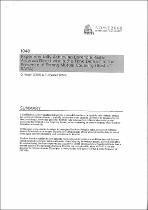 ResearchSpace
ResearchSpace
Experimentally achieving borehole antenna radar directivity in the time domain in the presence of strong mutual coupling
JavaScript is disabled for your browser. Some features of this site may not work without it.
- ResearchSpace
- →
- Research Publications/Outputs
- →
- Conference Publications
- →
- View Item
| dc.contributor.author |
Vogt, D

|
|
| dc.contributor.author |
Nyareli, T

|
|
| dc.date.accessioned | 2010-08-19T12:38:02Z | |
| dc.date.available | 2010-08-19T12:38:02Z | |
| dc.date.issued | 2008-06 | |
| dc.identifier.citation | Vogt, D and Nyareli, T. 2008. Experimentally achieving borehole antenna radar directivity in the time domain in the presence of strong mutual coupling. 70th EAGE (European Association of Geoscientists and Engineers) Conference. Rome, italy, 9 - 12 June 2008, pp 7 | en |
| dc.identifier.isbn | 9789073781535 | |
| dc.identifier.uri | http://hdl.handle.net/10204/4171 | |
| dc.description | 70th EAGE (European Association of Geoscientists and Engineers) Conference. Rome, Italy, June 2008 | en |
| dc.description.abstract | It is difficult to achieve significant directivity in the radial direction of a borehole radar antenna, because the spacing of antenna elements is typically constrained by the borehole diameter to be considerably less than a wavelength. Previously published borehole radar antennas have achieved directivity by post processing data received in the frequency domain, or by constructing an aperture antenna, where borehole dimensions allowed this. In this paper, a time-domain technique is investigated for determining the radial direction of reflectors detected in borehole radar images. The antenna itself is an array of four elements and the delay in arrival of the signal between elements is used to determine its direction. We show here that a relatively slow sampling rate is adequate to resolve the small time intervals between signals received on different antenna elements. Mutual coupling between the antenna elements does affect the relative timing, but does not prevent the extraction of usable directional data. Experimental data from a test tank confirms that estimates of reflector direction can be made to within avout +15 degrees /-5 degrees of the true direction for antenna elements 20 mm apart in water, excited with a pulse that has a centre frequency of 250 MHz | en |
| dc.language.iso | en | en |
| dc.publisher | European Association of Geoscientists and Engineers | en |
| dc.subject | Borehole radar | en |
| dc.subject | Directional antennas | en |
| dc.subject | Time domain | en |
| dc.subject | 70th EAGE | en |
| dc.title | Experimentally achieving borehole antenna radar directivity in the time domain in the presence of strong mutual coupling | en |
| dc.type | Conference Presentation | en |
| dc.identifier.apacitation | Vogt, D., & Nyareli, T. (2008). Experimentally achieving borehole antenna radar directivity in the time domain in the presence of strong mutual coupling. European Association of Geoscientists and Engineers. http://hdl.handle.net/10204/4171 | en_ZA |
| dc.identifier.chicagocitation | Vogt, D, and T Nyareli. "Experimentally achieving borehole antenna radar directivity in the time domain in the presence of strong mutual coupling." (2008): http://hdl.handle.net/10204/4171 | en_ZA |
| dc.identifier.vancouvercitation | Vogt D, Nyareli T, Experimentally achieving borehole antenna radar directivity in the time domain in the presence of strong mutual coupling; European Association of Geoscientists and Engineers; 2008. http://hdl.handle.net/10204/4171 . | en_ZA |
| dc.identifier.ris | TY - Conference Presentation AU - Vogt, D AU - Nyareli, T AB - It is difficult to achieve significant directivity in the radial direction of a borehole radar antenna, because the spacing of antenna elements is typically constrained by the borehole diameter to be considerably less than a wavelength. Previously published borehole radar antennas have achieved directivity by post processing data received in the frequency domain, or by constructing an aperture antenna, where borehole dimensions allowed this. In this paper, a time-domain technique is investigated for determining the radial direction of reflectors detected in borehole radar images. The antenna itself is an array of four elements and the delay in arrival of the signal between elements is used to determine its direction. We show here that a relatively slow sampling rate is adequate to resolve the small time intervals between signals received on different antenna elements. Mutual coupling between the antenna elements does affect the relative timing, but does not prevent the extraction of usable directional data. Experimental data from a test tank confirms that estimates of reflector direction can be made to within avout +15 degrees /-5 degrees of the true direction for antenna elements 20 mm apart in water, excited with a pulse that has a centre frequency of 250 MHz DA - 2008-06 DB - ResearchSpace DP - CSIR KW - Borehole radar KW - Directional antennas KW - Time domain KW - 70th EAGE LK - https://researchspace.csir.co.za PY - 2008 SM - 9789073781535 T1 - Experimentally achieving borehole antenna radar directivity in the time domain in the presence of strong mutual coupling TI - Experimentally achieving borehole antenna radar directivity in the time domain in the presence of strong mutual coupling UR - http://hdl.handle.net/10204/4171 ER - | en_ZA |





